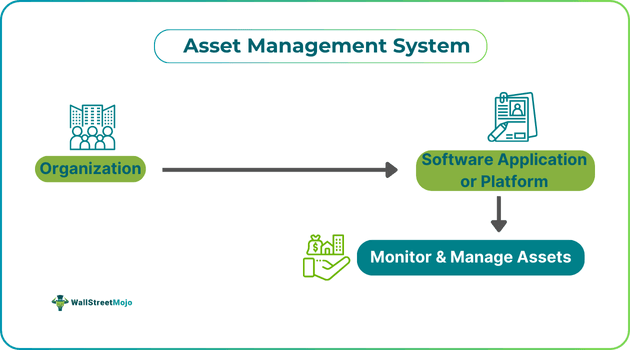Table of Contents
What Is Asset Management System?
An Asset Management System (AMS) is a framework developed by organizations to track and manage their assets and inventory on a daily basis. The primary goal of an AMS is to help organizations efficiently manage the lifecycle of their assets.

Asset management software is installed in most enterprises to manage data and assets effectively. This software assists in tracking IT equipment, inventory, vehicles, tools, and industrial or manufacturing resources, providing real-time updates on their performance. As a result, applying depreciation becomes easier and more efficient.
Key Takeaways
- An Asset Management System (AMS) is a structured framework designed to track, monitor, manage, and maintain the assets owned by an organization.
- AMS is part of asset management, focusing on acquiring, tracking, and disposing of assets, helping streamline these processes.
- There are various types of AMS, including inventory management, digital asset management, enterprise asset management, facility management, and IT asset management systems.
- AMS enables smooth reporting, audit preparation, and effective delegation of asset management tasks using dedicated software.
Asset Management System Explained
An asset management system is a structured system designed specifically to manage, track, and monitor the assets within an organization. It functions as a watchdog over the data in the asset repository, monitoring the quantity, quality, status, and ownership of assets. For example, if a vehicle is sold, the AMS records the change, updating the asset count accordingly. This makes it easier for owners to apply depreciation accurately, preventing errors in financial reports.
The AMS mechanism involves tracking and reporting on assets owned by the entity. It begins with the asset manager listing all items considered assets. Using AMS software, the manager develops a comprehensive plan to manage these assets effectively. Over time, the manager ensures asset optimization (minimizing waste) across the organization. Lifecycle management tracks assets from acquisition to disposal, including maintenance planning and scheduling. Additionally, the AMS provides insights into asset performance and enables regulatory compliance, aiding in audit preparation and monitoring asset-related risks.
Many organizations deploy AMS software to automate asset tracking throughout its lifecycle, reducing the need for manual processes. However, choosing the right software can be challenging. It's crucial to consider business goals, budget, security features, and personal preferences before selecting one.
Types
There are different types of AMS popular among organizations and corporations. Let’s briefly explore each type:
- Digital Asset Management System: This system is designed to organize digital assets or data stored in digital space efficiently. With digitalization permeating every aspect of life, brands and companies increasingly rely on media, marketing, and emails. A digital asset management system creates a digital library for all media and digital assets, accessible anytime when needed.
- Enterprise Asset Management (EAM): In a business context, enterprise asset management focuses on maintaining and managing an organization’s physical assets. This system is particularly beneficial for firms in sectors like healthcare, energy, manufacturing, telecommunications, finance, and education. EAM provides real-time information on these assets, enabling organizations to optimize asset quality and reliability.
- Inventory Management System: This system tracks inventory movement from the warehouse to the end customer. AMS software helps businesses record inventory and manage warehouse operations along with logistics, ensuring smooth inventory tracking and control.
- Facility Management System: Designed for managing the facilities provided by an organization, this system helps maintain and organize real estate spaces such as buildings, infrastructure, and utilities. Firms can use AMS for facility planning, energy management, space optimization, and lease management.
- IT Asset Management System: Specifically tailored for managing IT assets, this system helps organizations keep track of hardware, software, applications, digital documents, licenses, agreements, and more. An IT asset management system centralizes all IT-related assets, reducing the risk of cybersecurity mishaps.
Examples
Let us look at examples of how firms deploy AMS in their network and reap the ultimate benefits of this system:
Example #1
James owns a technology company that develops software and chips for its clients. His company holds licenses and ongoing agreements with multiple clients and has a marketing team that actively posts on social media for audience engagement. James decided to install asset management software beforehand because of potential data and asset loss during an office relocation.
With this new AMS, James can centralize all his data, licenses, and agreements in one place. He can also track upcoming expiration dates and renew licenses and agreements in advance.
Example #2
The U.S. Federal Trade Commission (FTC) has proposed a rule banning post-employment non-compete agreements, which have traditionally protected trade secrets by preventing employees from joining competitors. With this change, companies will need to safeguard trade secrets through internal systems like automated trade secret asset management, which involves identifying, classifying, protecting, and valuing these assets using advanced technologies such as blockchain.
Benefits
An Asset Management System (AMS) provides numerous advantages to organizations that implement it. Let’s explore some of the key benefits:
- Easy Tracking System: AMS allows for seamless tracking of an organization's assets. It enables users to locate, monitor, and optimize assets as needed, ensuring efficient asset management.
- Smooth Reporting: AMS software enables the analysis of an asset’s performance throughout its lifecycle, from acquisition to disposal. Managers can use this data to report asset usage to senior leadership and accurately account for it in financial records. Additionally, it can notify management when an asset is nearing the end of its life, signaling the need for replacement.
- Effective Audits: AMS serves as a valuable tool for creating detailed reports on assets. These reports consolidate various data sets, providing insights for better decision-making. The finance team can also leverage this feature to generate financial statements for stakeholders, enhancing the accuracy and transparency of audits.
